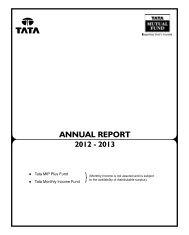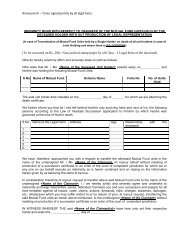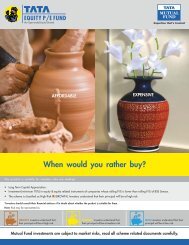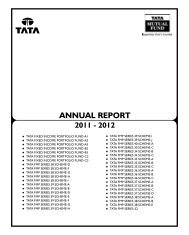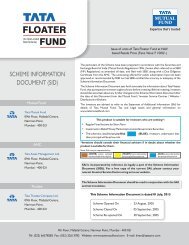Tata Fixed Tenure Fund Series - 2 Scheme B - Securities and ...
Tata Fixed Tenure Fund Series - 2 Scheme B - Securities and ...
Tata Fixed Tenure Fund Series - 2 Scheme B - Securities and ...
Create successful ePaper yourself
Turn your PDF publications into a flip-book with our unique Google optimized e-Paper software.
TATA FIXED TENURE FUND SERIES 2<br />
In pursuance to SEBI communication dated 25.8.2010, given below are the requisite details relating to investments in Securitised debt.<br />
1. Risk profile of securitized debt vis a vis risk appetite of the scheme:<br />
Securitized Debt is a financial instrument (bond) whose interest <strong>and</strong> principal payments are backed by an underlying cash flow from another asset. In<br />
line with the investment strategy of the <strong>Scheme</strong> <strong>and</strong> considering that there would be no intermediate redemption pressures for the <strong>Fund</strong> Manager, the<br />
<strong>Scheme</strong> may take exposure to rated Securitized Debt with the intent to enhance portfolio yield without compromising on credit quality. Exposure to<br />
Securitized Debt in the <strong>Scheme</strong>/Plan will be limited to papers with maturity not exceeding the maturity of the <strong>Scheme</strong>/Plan. Further as a prudent<br />
measure of risk control, Investment in Securitized Debt will not exceed 50% of the net assets of the <strong>Scheme</strong>.<br />
2. Policy relating to originators based on nature of originator, track record, NPAs, losses in earlier securitized debt, etc<br />
The Policy relating to evaluation of the originators is as under:<br />
• Track record<br />
• Willingness to pay, through credit enhancement facilities etc.<br />
• Ability to pay<br />
• Business risk assessment, wherein following factors are considered:<br />
- Outlook for the economy (domestic <strong>and</strong> global)<br />
- Outlook for the industry<br />
- Company specific factors<br />
Track record<br />
We ensure that there is adequate past track record of the Originator before selection of the pool including a detailed look at the number of<br />
issuances in past, track record of issuances, experience of issuance team, etc. We also look at the credit profile of the Originator for its own<br />
debt. We normally invest only if the Originator’s credit rating is at least ‘AA’ (+/- or equivalent) or above by a credit rating agency recognized by<br />
SEBI.<br />
Willingness to pay<br />
As the securitized structure has underlying collateral structure, depending on the asset class, historical NPA trend <strong>and</strong> other pool / loan<br />
characteristics, a credit enhancement in the form of cash collateral, such as fixed deposit, bank guarantee etc. is obtained, as a risk mitigation<br />
measure.<br />
Ability to pay<br />
This assessment is based on a detailed financial risk assessment.<br />
A traditional SWOT analysis is used for identifying company specific financial risks. One of the most important factors for assessment is the<br />
quality of management based on its past track record <strong>and</strong> feedback from market participants. In order to assess financial risk a broad<br />
assessment of the issuer’s financial statements is undertaken to review its ability to undergo stress on cash flows <strong>and</strong> asset quality.<br />
Business risk assessment, wherein following factors are considered:<br />
- Outlook for the economy (domestic <strong>and</strong> global)<br />
- Outlook for the industry<br />
- Company specific factors<br />
In addition a detailed review <strong>and</strong> assessment of rating rationale is done including interactions with the company as well as agency.<br />
Typically we would avoid investing in securitization transaction (without specific risk mitigant strategies / additional cash/security collaterals/<br />
guarantees) if we have concerns on the following issues regarding the originator / underlying issuer:<br />
• High default track record/ frequent alteration of redemption conditions / covenants<br />
• High leverage ratios - both on a st<strong>and</strong>alone basis as well on a consolidated level/ group level. This is very important in case of single<br />
borrower loan sell down<br />
• Higher proportion of re-schedulement of underlying assets of the pool or loan<br />
• Higher proportion of overdue assets of the pool or the underlying loan<br />
• Poor reputation in market<br />
• Insufficient track record of servicing of the pool or the loan<br />
3. Risk mitigation strategies for investments with each kind of originator<br />
Risk Mitigation Strategies<br />
Investments in securitized debt will be done based on the assessment of the originator which is carried out by the <strong>Fixed</strong> Income team based<br />
on the in-house research capabilities as well as the inputs from the independent credit rating agencies.<br />
In order to mitigate the risk at the issuer/originator level, the <strong>Fixed</strong> Income team will consider various factors which will include:<br />
• size <strong>and</strong> reach of the originator<br />
• the infrastructure <strong>and</strong> follow-up mechanism<br />
• quality of information disseminated by the issuer/originator; <strong>and</strong><br />
• the Credit enhancement for different type of issuer/originator<br />
• the originator’s track record in that line of business<br />
9




